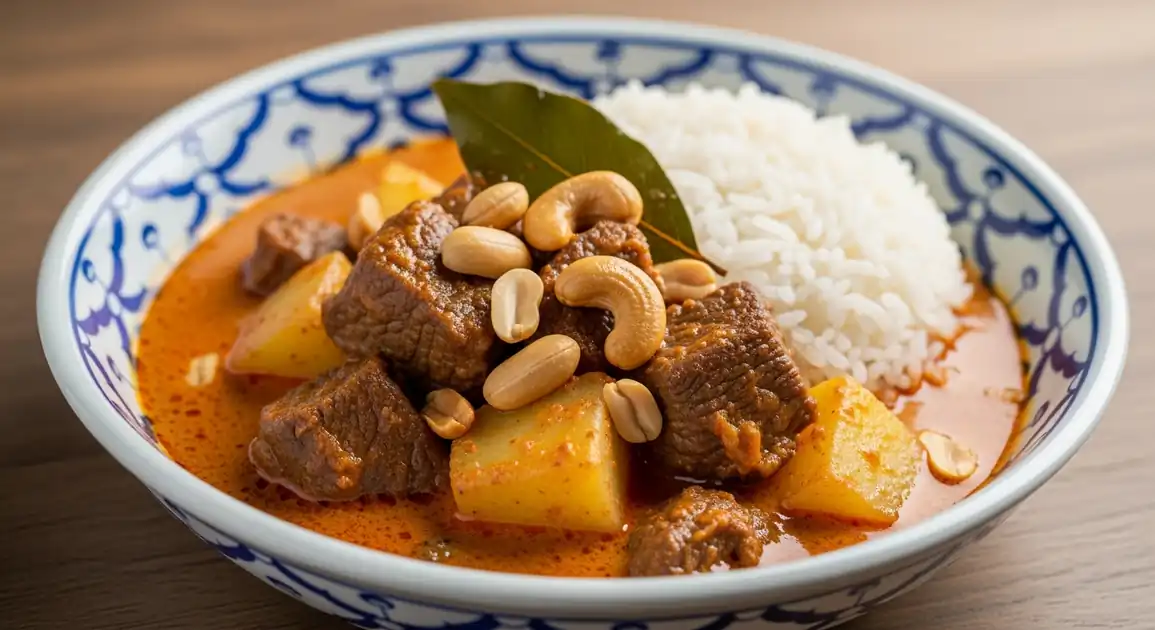Massaman Curry
แกงมัสมั่น

Description
Phuket, with its strong Southern Thai heritage and significant Muslim population, offers excellent and authentic Massaman Curry. You'll find it in local Muslim eateries ('Raan Khao Mok Gai'), Southern Thai specialty restaurants, and tourist-focused venues across the island. Expect rich flavors, often highlighting the traditional spice blend.
Dietary Information
Serving information
Serving style
Served with steamed rice. Sometimes accompanied by a small side of 'Ajat' (pickled cucumber, shallots, and chili in vinegar syrup) to cut the richness.
Quick facts
Local spots may open early for breakfast/lunch (9 AM - 4 PM). Tourist restaurants typically 11 AM - 11 PM.
Safety Tips
What to Look For
-
Served piping hot
Ensures the curry is freshly cooked or properly reheated to kill potential bacteria, especially important for meat dishes.
-
Tender meat consistency
Indicates the meat has been cooked thoroughly for a sufficient time, making it safe and palatable.
-
Rich aroma of spices and coconut
A good sign of fresh ingredients and proper preparation. Lack of aroma might suggest an old or poorly made batch.
-
Visible presence of key ingredients
Look for potatoes, onions, and peanuts/cashews which are characteristic of authentic Massaman.
-
Clean serving area and utensils
Observe the general hygiene of the restaurant or stall, including serving spoons and storage of ingredients.
-
Clear communication about ingredients (allergens)
Staff should be able to answer basic questions about ingredients, especially allergens like peanuts, tree nuts, fish sauce, and shrimp paste.
What to avoid
-
Lukewarm curry
Curry kept at improper temperatures is a breeding ground for bacteria. Insist on hot curry.
-
Meat that looks dry, tough, or old
Suggests improper cooking, reheating, or that the curry has been sitting for too long.
-
Excessive oil separation
While some oil separation is normal and desired ('cracked' coconut cream), a very thick layer of old-looking oil might indicate the curry is old or has been reheated multiple times improperly.
-
Unclean serving spoons or communal pots
Risk of cross-contamination from dirty utensils or customers handling spoons improperly.
-
Vendors unable/unwilling to discuss ingredients
Especially concerning for allergy sufferers. Choose vendors who can provide basic information.
Price information
Price range
Budget tips
- Explore Phuket Town for local Muslim restaurants ('Roti shops' often sell curries too) offering authentic Massaman at lower prices (80-150 THB).
- Local markets away from main beaches might have curry stalls.
- Beachfront restaurants will inevitably be more expensive (200-450+ THB).
Value indicators
- Authentic Southern Thai spice balance.
- Generous portions, especially in local eateries.
- Meat cooked until very tender.
- Often served with 'Ajat' (cucumber relish) alongside.
Where to Find This Dish
Phuket Town
Explore the streets around the old town and local markets for authentic Muslim and Southern Thai restaurants.
Thalang Road, Near Jui Tui Shrine, Downtown Market (Talat Sod)
Lunch, Dinner
Patong / Kata / Karon (Beach Areas)
Numerous restaurants catering to tourists offer Massaman, quality can vary. Look for busy places.
Beach roads, Main restaurant strips
Lunch, Dinner
Cherngtalay / Laguna Area
Mix of local eateries near the villages and more upscale restaurants within the resort complexes.
Boat Avenue, Local markets near mosques
Lunch, Dinner
Vendor Tips
- Seek out restaurants advertising 'อาหารใต้' (Ahaan Tai - Southern Food) or 'อาหารอิสลาม' (Ahaan Islam - Islamic Food).
- Ask locals for recommendations ('ร้านไหนมีมัสมั่นอร่อย?' - Raan nai mee Massaman aroi? - Which shop has delicious Massaman?).
- Be clear about allergies (peanuts!) as it's a key ingredient here.
How to Order
Regional Variations
-
Massaman Goat
(มัสมั่นแพะ (Massaman Phae))
Goat meat is more commonly used in Southern Thai Muslim cuisine compared to other regions, so Massaman Goat might be found.
-
Richer Coconut Cream
(กะทิเข้มข้น (Gathi Khem Khon))
Southern Thai curries are often known for their very rich, undiluted coconut cream base, which might be noticeable in Phuket's Massaman.
-
Side of Ajat
(อาจาด (Ajat))
Serving Massaman with Ajat (cucumber relish) is more common in Southern Thailand including Phuket.
Cultural context
History
Massaman Curry's origins are traced to 17th century Siam (Thailand) through Persian merchants and envoys, possibly influencing the royal court cuisine. The name 'Massaman' is thought to derive from 'Musalman,' an old Persian word for Muslim, highlighting its connection to Muslim traders and Southern Thai Muslim communities. The use of dry spices like cardamom and cinnamon distinguishes it from typical Thai curries and points to foreign influences. It has since become a beloved dish throughout Thailand and internationally recognized.
Local significance
Massaman is a prominent dish in Phuket's culinary landscape, reflecting the island's Southern Thai identity and historical Muslim influences.
Eating customs
- Eaten with rice. The accompanying 'Ajat' pickle is often served in the South to provide a refreshing contrast.
- Sharing dishes is standard practice.